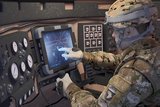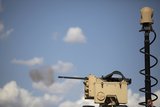How is artificial intelligence changing the face of modern warfare? (Studio)
Brought to you in partnership with Systel
Artificial Intelligence (AI) is no longer the stuff of science fiction but part of everyday reality.
AI can now be found in a vast range of military technology, from autonomous systems to data-gathering sensors.
It enhances productivity, reduces operator workloads and speeds applications through concepts like machine learning (ML), where a machine can improve with experience; for example, an algorithm could learn over time to detect a particular threat.
AI is transforming modern warfare – and we are only at the beginning. Speaking at the Air & Space Power Conference in 2020, Air Vice-Marshal Lincoln Taylor, chief of staff capability at the UK RAF’s HQ Air Command, said that ‘exploiting artificial intelligence offers choice to commanders and governments’.
It can signal adversary intent before behaviour, offering political choice and closing adversary choice, he noted.
‘It offers better insight into our own OODA [Observe, Orient, Decide, Act] loop, acting more quickly with more insight more effectively, and rendering an adversary’s actions more and more irrelevant,’ he said.
Against this backdrop of evolving military needs, AI is a key focus today for industry.
Systel is a US-based manufacturer of rugged computers for tactical vehicle and platform use for mission-critical applications; its products include the Kite-Strike embedded edge supercomputer and the Raven-Strike fully ruggedised mission computer. Such systems sit right at the heart of AI development and edge-deployment.

Much of the burden can now be removed from human personnel and placed onto the machine element, according to Aneesh Kothari, Systel’s vice president for marketing.
Across the service branches, this means ‘moving past the limits of human capacities for mission-critical data processing workloads and shifting the cognitive burden and safety risk from man to machine’, Kothari said.
He highlighted a range of projects with this concept in mind, such as the US Army’s Robotic Combat Vehicle (RCV) programme or the US Air Force’s “Skyborg” robotic wingman concept.
The application benefits and possibilities are seemingly limitless, including areas such as cyber and electronic warfare and defense, counter-UAS, and facial and target detection and recognition.
Although Systel does not see itself as an AI company, ‘the ubiquitous, prevalent nature of AI in every programme and set of requirements flows down to us [from] both our prime customers and government customers’, Kothari explained.
This has transformed the manufacturer’s thinking. Systel is now an ‘AI-enabling company’, with the technology running on a backbone of its rugged hardware computing systems.
AI is also a primary focus for some of the biggest names in defence, such as Raytheon Technologies.
While AI is having an effect across the board, Raytheon is pursuing specialised AI programmes. One of these is CASPER (Cognitive Aids to Sensor Processing, Exploitation and Response), an intelligent software suite that lightens the operator’s workload and helps speed their decision-making through automation.
AI and autonomy are essential tools to help counter new weapon systems, said Jim Wright, Raytheon Intelligence & Space (RI&S) technical director for Intelligence, Surveillance and Reconnaissance (ISR) Systems.
Concepts like hypersonic glide vehicles dramatically shorten kill chain timelines, he noted, meaning ‘the time you have from when you see them to when you’d better address them is extraordinarily short’.
This must be achieved using multiple sensors across a network, Wright noted. The confluence of large amounts of data and the short timelines ‘drives you to automation and autonomy, and certainly, the technology of AI/ML is fundamental to enable that’.

Robotic Research is an autonomous operations specialist that works in both the commercial and military sectors.
The company has developed AutoDrive-M, an Autonomy Kit that can be installed on any tactical wheeled vehicle, as part of the Autonomous Ground Resupply and Expedient Leader-Follower programmes from the US Army’s Combat Capabilities Development Command’s Ground Vehicle Systems Center.
Despite the evolution of AI, it remains essential to keep a human in the loop. According to James Frelk, senior vice president at Robotic Research, the Leader-Follower concept relies on a person in the lead vehicle, who can be alerted by the system if they have to intervene on any level.
‘There’s always safety cases … how much do you want the autonomous system using AI to do, and when do you want it to alert the human brain to take a look at things?’ Frelk said.
This ties into broader challenges around ethics, a significant consideration for industry as the AI race heats up worldwide. We are still in the early days of the technology, noted Chris Worley, director for civil and digital solutions at RI&S.
While we can predict a certain element of AI’s benefits, ‘it’s the unintended consequences, the third-order effects that you’re going to have to look at’, he said. That’s why there is so much emphasis on the framework of ethics and principles, so that ‘we understand the true scope of what we’re trying to work through’.
As with any area of rapid military development, efforts are underway to counter AI. Wright notes that something as simple as placing two pieces of tape on a Stop sign could confuse the AI into thinking it is something else entirely.
This type of challenge must be front of mind for developers, he said. ‘We have to look at that … before we start fielding stuff.’
So what comes next? As peer and near-peer competitors make advances of their own, AI will play a key role in the joint all domain command and control or JADC2 battlefield of the future, said Kothari.
‘AI and ML is the key to accomplishing the JADC2 objectives of a unified network with any sensor connected to any shooter. Combat overmatch will be accomplished through decision dominance, with AI acting as the driving force..’
More from The Artificial Intelligence on the Battlefield podcast
-
![Artificial intelligence and the human-machine interface (podcast)]()
Artificial intelligence and the human-machine interface (podcast)
The third episode of Shephard Studio’s Artificial Intelligence on the Battlefield podcast, sponsored by our partner Systel, looks more closely at the future of the human-machine interface.
-
![Putting the soldier at the centre of AI design (Studio)]()
Putting the soldier at the centre of AI design (Studio)
Militaries are turning to soldier-centred design to maximise the benefits of AI technology, placing humans at the centre of their development efforts.
-
![Artificial intelligence becomes the critical enabler of future operations (Studio)]()
Artificial intelligence becomes the critical enabler of future operations (Studio)
The US and its allies have found themselves in the middle of an AI arms race, with the prize of decision dominance on the battlefield for whoever gets there first.
-
![Artificial intelligence and multi-domain operations (podcast)]()
Artificial intelligence and multi-domain operations (podcast)
The second episode of Shephard Studio’s Artificial Intelligence on the Battlefield podcast, sponsored by our partner Systel, looks more closely at the military applications of AI.
-
![Artificial intelligence and warfare - an introduction (podcast)]()
Artificial intelligence and warfare - an introduction (podcast)
Introducing Shephard Studio’s Artificial Intelligence on the Battlefield podcast, sponsored by our partner Systel.
-
![Systel launches Kite-Strike, a next-generation embedded edge supercomputer (sponsored video)]()
Systel launches Kite-Strike, a next-generation embedded edge supercomputer (sponsored video)
Watch how the next generation of combat vehicles will employ advanced AI algorithms to lower the burden on the human operator.



























